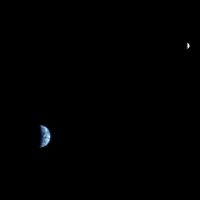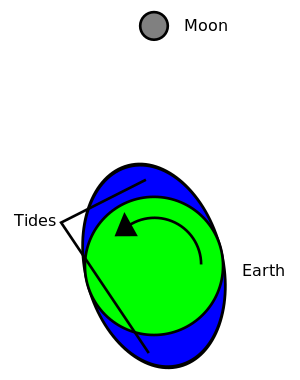احتكاك مدي (فلك)
الاحتكاك المدي هو قوة يحدثها المد والجزر تعمل على إبطاء حركة دوران الكرة الارضية حول محورها ومن نتائج هذا الاحتكاك ازدياد طول اليوم بمقدار 1,6 ثانية لكل 100,000 سنة.
نظام الأرض-القمر
تأثيرات جاذبية القمر
العزم الزاوي والطاقة
الدليل التاريخي
وصف كمي لحالة الأرض-القمر
يمكن تعقب حركة القمر بدقة بضعة سنتيمترات بواسطة lunar laser ranging (LLR). فنبضات الليزر ترتد من مرايا على سطح القمر، تم وضعها ضمن مهام كل من أپولو في سنوات 1969 حتى 1972 ورحلة لونوخود 2 في عام 1973.[1] Measuring the return time of the pulse yields a very accurate measure of the distance. هذه القياسات تم إيقاعها على معادلات الحركة. وهو ما أنتج قيم للمتغيرات، ومنهم secular acceleration. فمن فترة 1969–2001، النتيجة هي:
- (cy is centuries; the first is a quadratic term.)
This is consistent with results from satellite laser ranging (SLR), a similar technique applied to artificial satellites orbiting the Earth, which yields a model for the gravitational field of the Earth, including that of the tides. The model accurately predicts the changes in the motion of the Moon.
From the observed change in the Moon's orbit, the corresponding change in the length of the day can be computed:
- +2.3 ms/cy
- (cy in centuries).
However, from historical records over the past 2700 years the following average value is found:
The corresponding cumulative value is a parabola having a coefficient of T² (time in centuries squared) of:
- ΔT = +31 s/cy²
حالات أخرى من التسارع المدّي
التباطؤ المدي
انظر أيضا
المصادر
- مؤمن, عبد الأمير (2006). قاموس دار العلم الفلكي. بيروت، لبنان: دار العلم للملايين.
{{cite book}}: Cite has empty unknown parameter:|طبعة أولى coauthors=(help)
- ^ Another reflector emplaced by Lunokhod 1 in 1970 is no longer functioning.[1]
- ^ J.Chapront, M.Chapront-Touzé, G.Francou: "A new determination of lunar orbital parameters, precession constant, and tidal acceleration from LLR". Astron.Astrophys. 387, 700..709 (2002).
- ^ أ ب Jean O. Dickey et al. (1994): "Lunar Laser Ranging: a Continuing Legacy of the Apollo Program". Science 265, 482..490.
- ^ F.R. Stephenson (1997): Historical Eclipses and Earth's Rotation. Cambridge Univ.Press.

